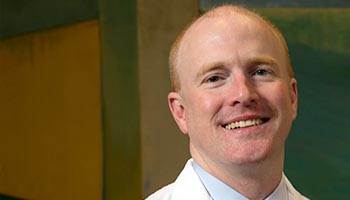HOW CAN WE HELP YOU? Call 1-800-TRY-CHOP
In This Section
Safest Cars; Welcome, Dr. Theodore Laetsch; Black Adolescent Males; Genetic Epilepsies; Aicardi-Goutières Syndrome

mcannn [at] email.chop.edu (By Nancy McCann)
In this week’s roundup of research headlines, read about the prioritization of driving the safest vehicle possible — especially for young and older drivers — and what Black adolescent males and their parents think about preventative care check-ups. Learn about studies that cover the longitudinal footprint of genetic epilepsies and the observed neurologic improvement in patients with Aicardi-Goutières syndrome (AGS), a rare, aggressive genetic disorder. And please join us as we welcome Theodore Laetsch, MD, to Children’s Hospital of Philadelphia Division of Oncology.
Research Underscores the Need to Drive the Safest Car You Can Afford

Kristi Busico Metzger, PhD, MPH
Teen drivers and those 65 years and older — two age groups at higher risk of being involved in an automobile accident — are more likely to be driving vehicles that are less safe, putting them at even higher risk of injury. These findings, from the Center for Injury Research and Prevention (CIRP) at Children’s Hospital of Philadelphia and published in Traffic Injury Prevention, underscore the need for these groups to prioritize driving the safest vehicle they can afford.
The study revealed:
- Teens and older drivers were more likely than middle-aged adults to drive older cars that did not have electronic stability control (ESC) or side and curtain air bags
- Drivers of all ages from lower-income neighborhoods were less likely to drive newer, safer cars
- On average, young drivers from lower-income neighborhoods drove vehicles that were almost twice as old as their peers from higher-income neighborhoods
- Young drivers from high-income neighborhoods were 53 percent more likely to drive cars with side airbags
- Older drivers from high-income neighborhoods were 35 percent more likely to have vehicles with side airbags than older drivers from low-income neighborhoods.
Ensuring drivers are behind the wheel of the safest vehicles they can afford, is a significant approach to reducing injuries related to crashes.
“All drivers should strive to be in the safest vehicle they can afford, regardless of age or income level,” said lead author Kristi Busico Metzger, PhD, MPH, a statistical scientist with CIRP. “There are many vehicles available with key safety features that won’t break the bank, some for less than $7,000.”
To learn more, read Dr. Metzger’s insightful commentary in CIRP’s Research In Action Blog, this Philadelphia Inquirer article, or go to CHOP News.
Extending a Warm CHOP Welcome to Dr. Theodore Laetsch

Theodore Laetsch, MD
A big air high-five goes out to Theodore Laetsch, MD, a pediatric hematologist-oncologist who joined the Division of Oncology. He will launch and lead the Very Rare Malignant Tumors Program, which will seek to develop new treatments for children with rare and complex tumors. Dr. Laetsch also will direct CHOP’s Developmental Therapeutics Program and become the CHOP Primary Investigator of the National Cancer Institute Pediatric Early Phase Clinical Trials Network (PEP-CTN).
“We are excited for Dr. Laetsch’s return to CHOP [where he completed his fellowship] and take on these important and groundbreaking leadership roles,” said Stephen Hunger, MD, chief of the Division of Oncology and director of the Center for Childhood Cancer Research. “Dr. Laetsch is a rising star in pediatric oncology and is a key addition to our pediatric cancer program. With the launch of our Very Rare Malignant Tumors Program, Dr. Laetsch will lead an innovative new program that will develop breakthrough treatments for our patients.”
Read more at CHOP News.
Research Explores Value of Preventative Care as Voiced by Black Adolescent Males and Parents

George Dalembert, MD, MSHP
CHOP researchers sought out the patient voice in understanding how to address disparate rates in critical preventive care (check-ups) for adolescent Black males, in a study published in Academic Pediatrics.
The results of interviews with 23 Black adolescent males (mean age 15) and 22 parents (20 mothers), all of whom understood that teens should routinely receive preventive care, showed that Black adolescent males and their parents value regular preventive care as an opportunity to ensure the teen is physically and mentally well, but competing priorities interfere with care receipt. Further study is needed for testing the impact of reminders (a requested intervention from study participants) on receipt of care in this population.
“Due to the anxiety caused by COVID-19, the pandemic has had a detrimental effect on preventive care- seeking that would potentially provide resources for coping,” said lead author, George Dalembert, MD, MSHP, a core member of the Possibilities Project primary care innovation team and a faculty scholar with CHOP PolicyLab. “As adolescents and their caregivers think receiving preventive care is important to knowing teens are mentally and physically well, it’s potentially more helpful than ever to think about the barriers and facilitators of receiving preventive services and design disparities-mitigating interventions that incorporate their insights.”
Other CHOP researchers include Ima Samba; Victoria Miller, PhD; Carol Ford, MD; and Alexander Fiks, MD, MSCE.
New Computational Methods Provide Longitudinal Footprint of Genetic Epilepsies

Ingo Helbig, MD
By combining clinical information with large-scale genomic data, researchers affiliated with CHOP’s Epilepsy Neurogenetics Initiative (ENGIN) have successfully linked specific symptoms of childhood epilepsies with 11 causative genes. Genetics in Medicine published the findings.
“Our study is the first example in childhood neurological disorders to systematically connect genomic information with the medical records,” said senior author, Ingo Helbig, MD, director of the genomic and data science core of ENGIN. “This is really important as we need to understand the clinical features that children with genetic brain disorders, especially children with genetic epilepsies, develop over time. Using the technologies that we have developed, we can use the available data in the electronic medical records to bridge the gap between genetics and outcomes.”
For study details, see this CHOP press release.
Observed Neurologic Improvement in Patients with Rare, Aggressive Genetic Disorder

Adeline Vanderver, MD
The New England Journal of Medicine published a letter by CHOP researchers in which they discuss their study’s findings that showed some patients with Aicardi-Goutières syndrome (AGS), a rare and aggressive form of leukodystrophy, may benefit from receiving treatment with a class of targeted therapy drugs that could improve their neurologic function.
With AGS, the body’s immune system is destructive, targeting the brain’s white matter and causing most children with the disorder to experience mild to severe intellectual or physical impairments. Most children with AGS are unable to walk or talk and have multisystemic complications, including skin inflammation.
Prior studies have linked the activation of interferons — signaling proteins that respond to various immune disruptions — to exacerbated symptoms in AGS. In this study, CHOP researchers explored whether a class of small molecule inhibitor drugs called janus kinase (JAK) inhibitors could be used to block interferon activation in a way that helped these patients. They found it did help patients with AGS meet important developmental milestones.
“Because treatment options for AGS are limited, and the symptoms that these patients experience are so severe, there is a need to explore a wide variety of options,” said co-author Adeline Vanderver, MD, program director of the Leukodystrophy Center of Excellence. “Measuring neurologic improvements in these patients is a complex process, but the results of this study are encouraging, especially because we observed improvements even in patients with severe and long-standing disease.”
See this press release for study details.
ICYMI
Catch up on our headlines from our Aug. 28 In the News:
- New Study Finds Signs of Altruism in Individuals’ COVID-19 Concerns
- PolicyLab Joins Good Morning America to Discuss Safe School Reopening
- Vaccine Expert Gives Update on COVID-19 Vaccine Development for JAMA
- CHOP Researchers Evaluate Promising Coronavirus Vaccine
- CHOP Sepsis Research Featured in NIH Director’s Blog
- Fewer Serious Asthma Events After COVID-19 Stay-At-Home Orders
Keep up with our news, stories, and updates in real time by following us on Twitter, Facebook, LinkedIn, or Instagram. Or subscribe to our newsletter to get an email sent every other Friday by signing up here.


